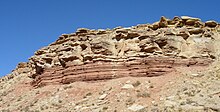From Wikipedia, the free encyclopedia
|
|
The examples and perspective in this article deal primarily with the United States and Europe and do not represent a worldwide view of the subject. (July 2015) (Learn how and when to remove this template message) |
Middle Triassic marginal marine sequence of siltstones (reddish layers at the cliff base) and limestones (brown rocks above), Virgin Formation, southwestern Utah, USA
Sedimentary rocks on Mars, investigated by NASA's Curiosity Mars rover
Steeply dipping sedimentary rock strata along the Chalous Road in northern Iran
The sedimentary rock cover of the continents of the Earth's crust is extensive (73% of the Earth's current land surface[1]), but the total contribution of sedimentary rocks is estimated to be only 8% of the total volume of the crust.[2] Sedimentary rocks are only a thin veneer over a crust consisting mainly of igneous and metamorphic rocks. Sedimentary rocks are deposited in layers as strata, forming a structure called bedding. The study of sedimentary rocks and rock strata provides information about the subsurface that is useful for civil engineering, for example in the construction of roads, houses, tunnels, canals or other structures. Sedimentary rocks are also important sources of natural resources like coal, fossil fuels, drinking water or ores.
The study of the sequence of sedimentary rock strata is the main source for an understanding of the Earth's history, including palaeogeography, paleoclimatology and the history of life. The scientific discipline that studies the properties and origin of sedimentary rocks is called sedimentology. Sedimentology is part of both geology and physical geography and overlaps partly with other disciplines in the Earth sciences, such as pedology, geomorphology, geochemistry and structural geology. Sedimentary rocks have also been found on Mars.



No comments:
Post a Comment